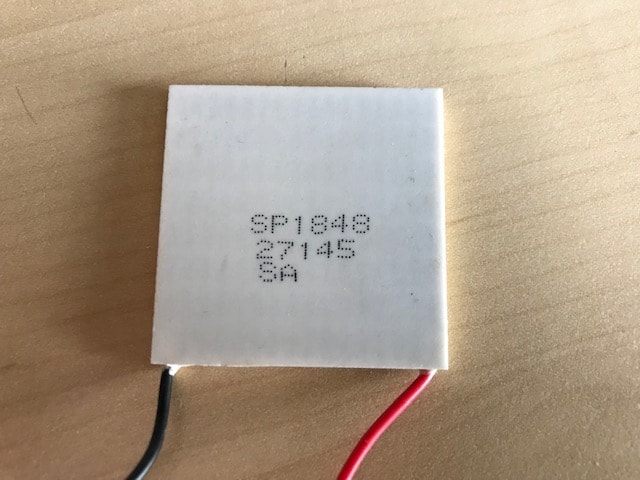A thermoelectric Peltier generator can convert heat to electricity. These modules generate electricity when both sides are exposed to a different temperature. For example, you can use fire to heat the thermoelectric generator while cooling the other side with water. These modules are easy to use and are a great way to generate electricity from heat!
Table of Contents
What is the Seebeck effect and how to generate electricity using a Peltier module?
The Seebeck effect is a phenomenon by which heat is dissipated through a semiconductor to generate electricity. These thermoelectric generators contain wires made from two different materials, such as copper and iron. These two types of wire lie on both sides and are interconnected. Therefore, this will generate a potential difference when the temperature is not the same on both sides. In other words, the thermoelectric Peltier module will generate electricity.
How to make a thermoelectric generator to convert heat to electricity?
It is easy to generate electricity with a Peltier module because all you need is to find the best way to achieve a greater temperature difference. For example, you could use a candle or small fire to heat one side of the thermoelectric generator. Indeed, thermoelectric Peltier generators are used commercially to build heat powered wood stove fans. To cool down the other side of the Peltier, you could also use water-containing ice cubes. A simple setup could be to use a thin can with a candle underneath and place a metal casserole with cold water on top.
Check this thermoelectric Peltier generator SP1848-27145 on Amazon
How much power can thermoelectric generator produce and what is its efficiency?
The efficiency of a thermoelectric Peltier module will vary a lot depending on the temperature difference achieved. Moreover, an important factor to consider is the contact between the Peltier and the other surfaces. An inadequate or uneven surface will therefore lower the efficiency. A good way to generate more electricity is also to use a thermal paste. It will ensure maximal energy dissipation between the surfaces.
As a reference, some SP1848-27145 thermoelectric modules also have data sheets indicating that they can generate approximately:
20 degrees temperature difference: 0.97V and 225 mA
40 degrees temperature difference: 1.8V and 368 mA
60 degrees temperature difference: 2.4V and 469 mA
80 degrees temperature difference: 3.6V and 558 mA
100 degrees temperature difference: 4.8V and 669 mA
These values can vary depending on your setup, wiring, and load. Check my digital multimeter tutorial to see how to measure the voltage and amperage produced by the thermoelectric generator.
Using it with a step-up converter to generate a specific voltage
If your goal is to reach and maintain a specific voltage, you can also use a step-up boost converter. These modules will increase the actual voltage of the thermoelectric generator to a fixed voltage value. For example, a boost converter will decrease the amperage to increase the voltage to the desired value like 3.3V or 5V. The disadvantage of this is that you further limit the amperage current. You can still use a step-up converter to power small electronic devices. Some people also use the thermoelectric generator to make a heat powered wood stove fan. Another alternative would be to use that in combination with a power bank to store the energy produced.
What kind of Peltier thermoelectric module to choose?
There are two main types of thermoelectric Peltier modules: thermoelectric coolers (TEC) and thermoelectric generators (TEG). These Peltier modules use the same technology but are designed for a specific purpose. You can use TEC for cooling devices. As a result, the current applied to a TEC can be used for cooling one of its sides. Such Peltier modules are not heat resistant and are also commonly used in thermoelectric refrigerators or air conditioning system. Check my previous post if you want to learn more about thermoelectric Peltier coolers.
On the other hand, thermoelectric generators are resistant to heat and are optimal for electricity production. These modules can stand temperatures as high as 150 degrees Celsius. Therefore, the thermoelectric generators can be used with a flame as the heating source and will be more efficient to generate electricity.
MiniO portable Peltier thermoelectric generator for camping: USB charger for phones and small electronics
This portable thermoelectric generator for camping is a good example of a commercial product using this technology. The thermoelectric generator MiniO is a neat and well-designed object. The Peltier generator is enclosed in a collapsible cup made of heat-resistant silicone and it is so easy to use! All you have to do is fill the cup with water and put it on any type of camping stove!
The MiniO is a portable thermoelectric generator ideal for camping. You can easily fit it in your backpack, as it measures only 4 inches by 1.5 inches once folded (10 x 4 cm). Its weight is not too bad either and it overall weighs less than a pound (350g).
Check the MiniO Portable Thermoelectric Generator for Camping with 5W USB Charging on Amazon
In addition, MiniO is an efficient thermoelectric generator. Its Peltier module can produce electricity and 5W of power, which is roughly the same as a regular phone charger. The USB output is also convenient for charging other small electronic devices.
Since thermoelectric generators produce more power with greater temperature differences, you can increase the amount of electricity produced by using cold water. Therefore, it would work even better if you were camping during the winter season and if you put ice or snow in the water reservoir to cool it further.
If you would like to see a portable thermoelectric generator in action, please have a look at the following video:
Conclusion
Thermoelectric Peltier generators are cheap and also easy to use. Although they don’t produce a lot of current, their main advantage is the simplicity of their design and usage. Therefore, thermoelectric generators are a good way to convert heat into electricity. They can even be used outdoors to generate electricity with a campfire!
See also my previous post about ultrasonic essential oil diffusion and its use in aromatherapy or to see how to do a simple Celsius to Fahrenheit conversion.

